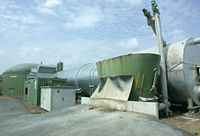
Photo from wikipedia
Biogas residue and organic manure are frequently used for crop planting. However, the evaluation of antibiotic resistant bacteria (ARB), antibiotic resistance genes (ARGs) and bacterial community before their applications to… Click to show full abstract
Biogas residue and organic manure are frequently used for crop planting. However, the evaluation of antibiotic resistant bacteria (ARB), antibiotic resistance genes (ARGs) and bacterial community before their applications to fields is still lacking. This study monitored the variations of bacteria resistant to sulfadiazine, tetracycline and norfloxacin, 57 resistance genes for sulfonamides, tetracyclines and fluoroquinolones as well as the bacterial community during the 28-day aerobic storage of biogas residue and organic manure by using viable plate counts, high-throughput qPCR and Illumina MiSeq sequencing methods. Then two storage conditions, incubator (25 °C) and natural environment, were used to assess the responses of ARB and ARGs to the environmental factors. Results showed that a total of 35 and 21 ARGs were detected in biogas residue and organic manure, respectively. ARB and ARGs were enriched up to 8.01-fold in biogas residue after the 28-day storage, but varied in a narrow range during the storage of organic manure. Compared with the incubator condition, the proliferation of ARB and ARGs in biogas residue under the natural condition was relatively inhibited by the varied and complicated environmental factors. However, we found that there was no significant difference of ARB and ARGs in organic manure between the incubator and natural conditions. Bacterial community was also shifted during the storage of biogas residue, especially Bacteroidetes_VC2.1_Bac22, Aequorivita, Luteimonas and Arenimonas. Network analysis revealed that the relationship in biogas residue was much more complicated than that in organic manure, which ultimately resulted in large successions of ARB and ARGs during the short-term storage of biogas residue. Therefore, we suggest that further measures should be taken before the application of biogas residue to fields.
Journal Title: Environmental pollution
Year Published: 2018
Link to full text (if available)
Share on Social Media: Sign Up to like & get
recommendations!